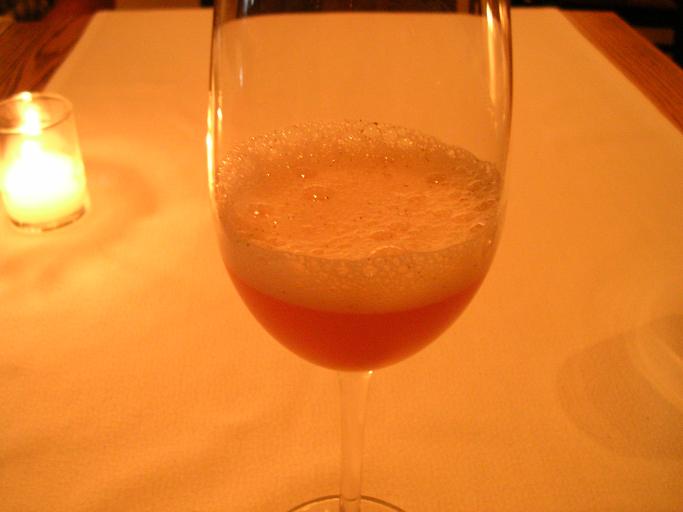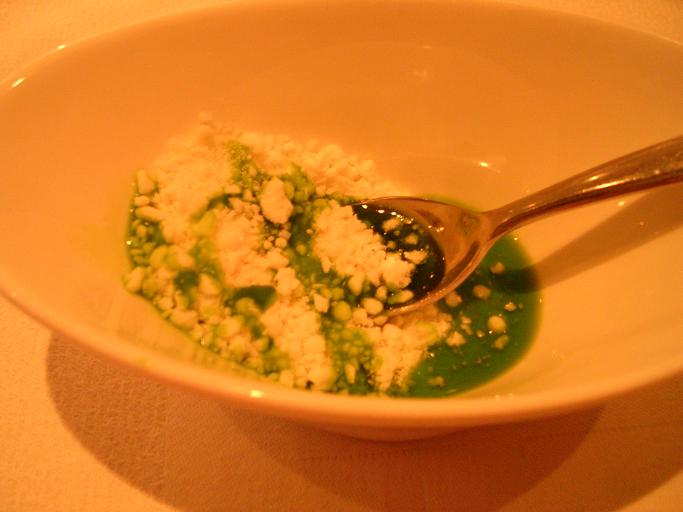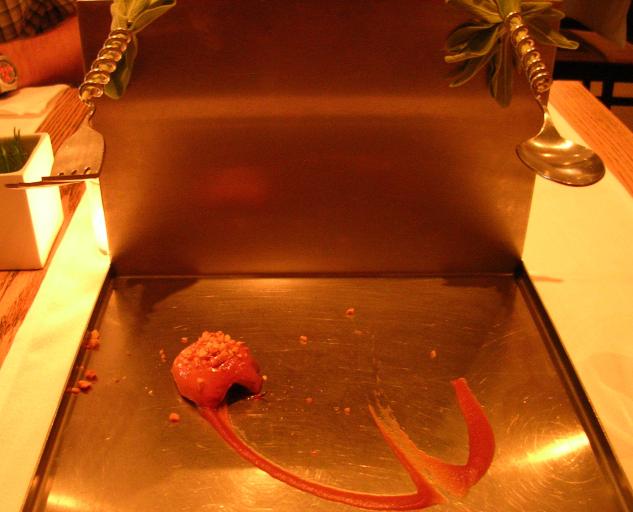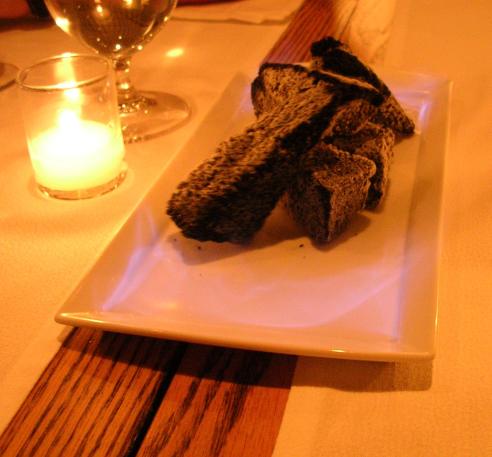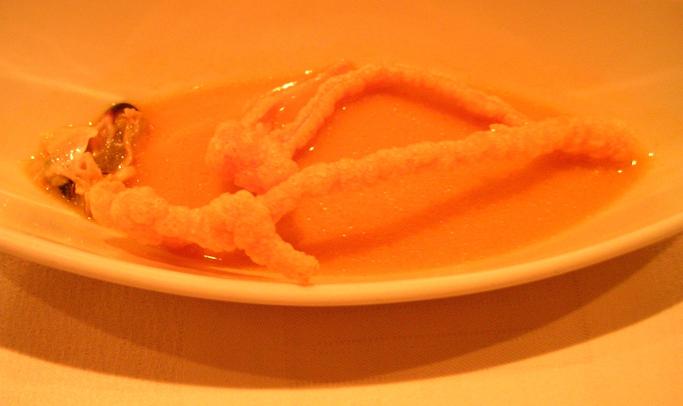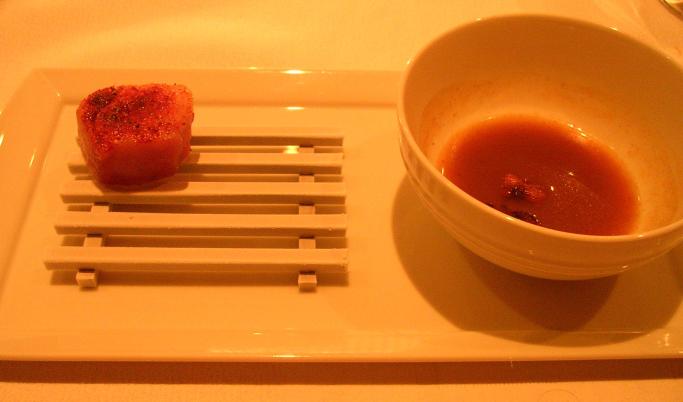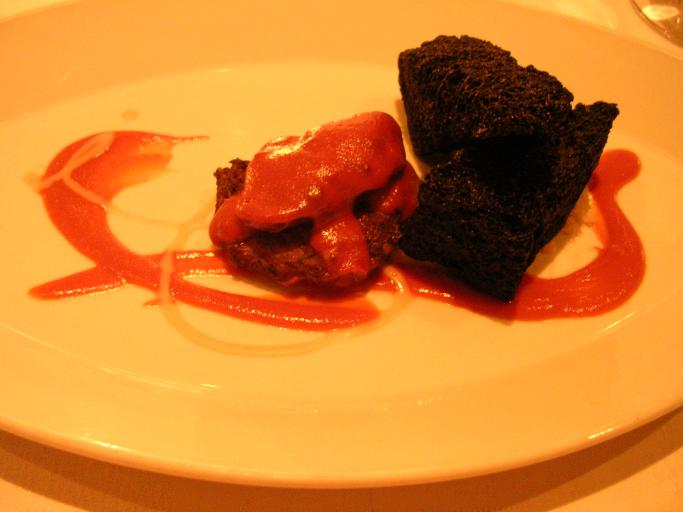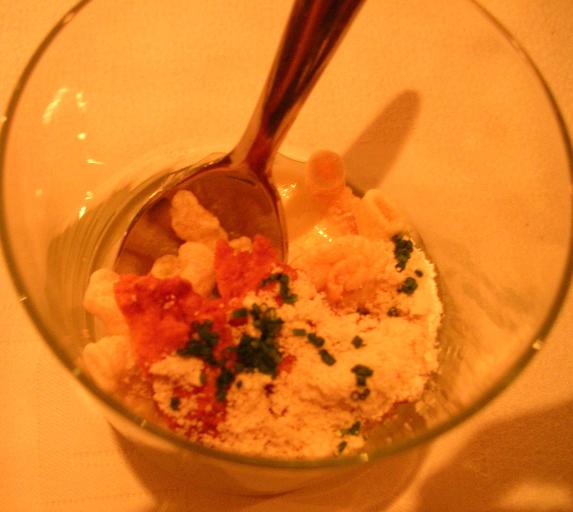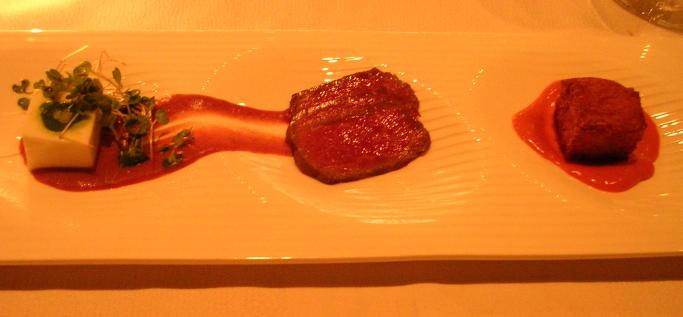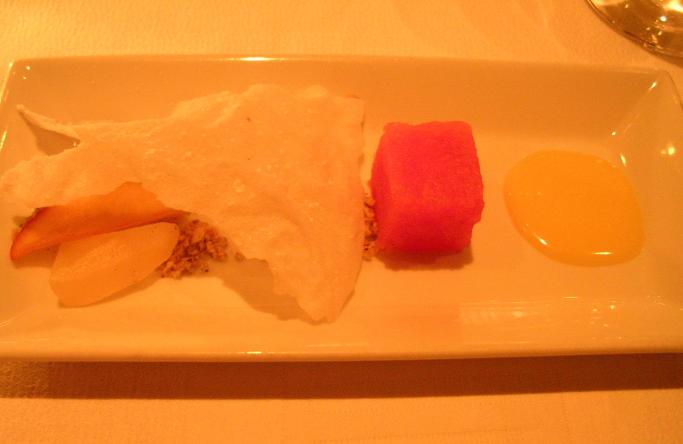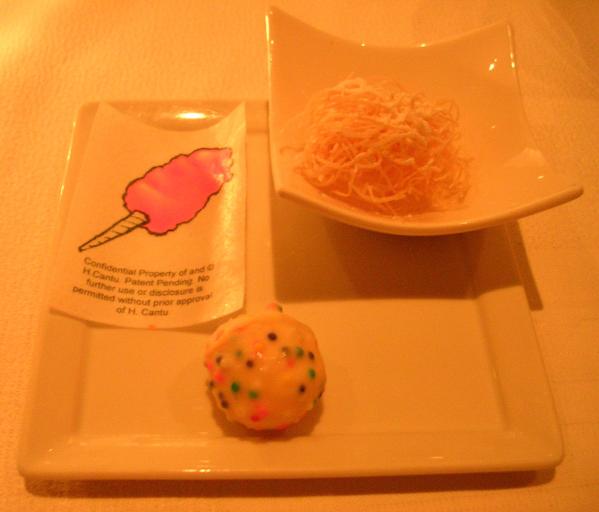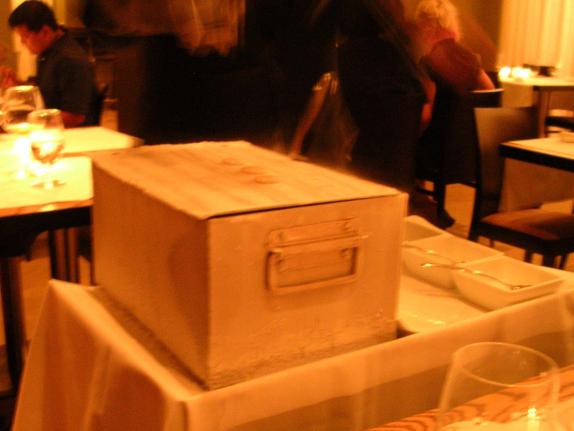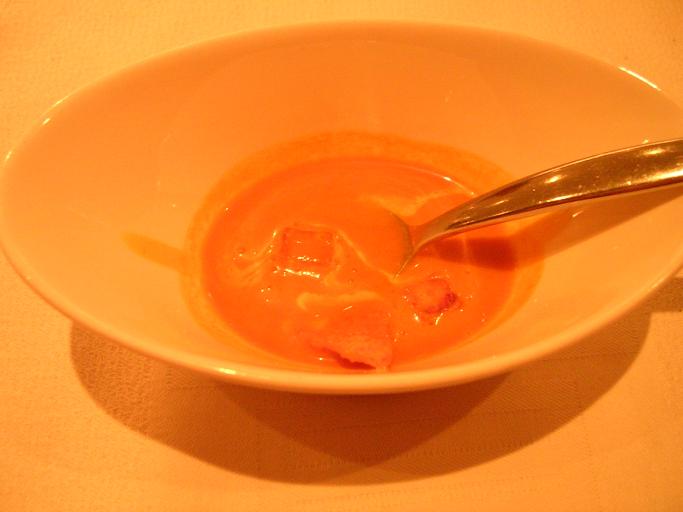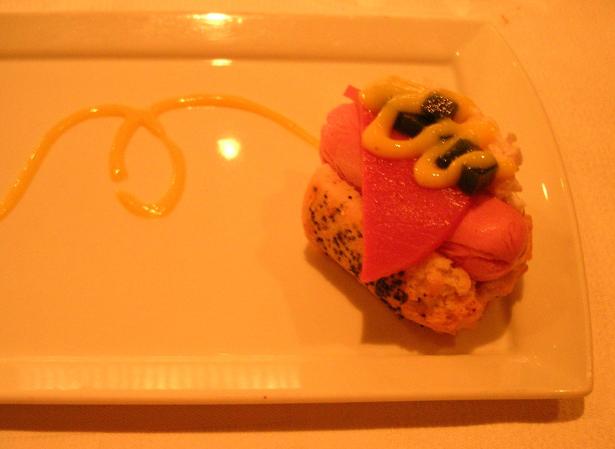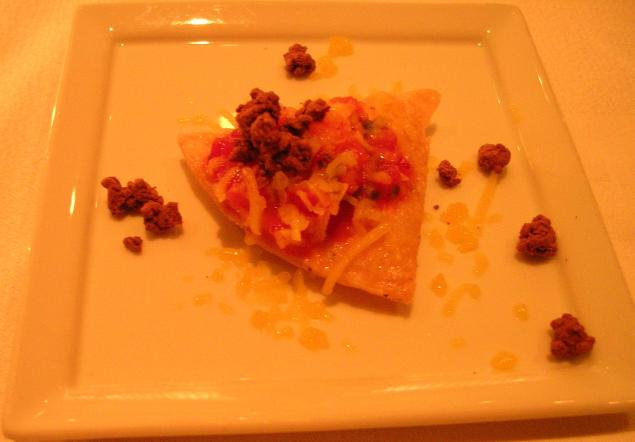Dinner at moto, September 4, 2007

Ever since my meal at elBulli in May of 2005, I’ve been itching for another great food experience. We’re blessed with lots of great local food and terrific restaurants here in the San Francisco area, but there isn’t anything like elBulli here, as others have complained. I did have dinner at the now-departed restaurants Antidote and Winterland, both of which took inspiration from the nueva cocina movement. They were good, but not nearly in the same league as EB. I’ve heard interesting things about Coi, although I haven’t been there yet. And I have really enjoyed the couple meals I’ve had at Manresa – they were among the very best I’ve had in the Bay Area, and very creative – but they didn’t have the same capacity to completely blow my mind.
While I was visiting my parents over Christmas in 2006, I was talking with my friend Jesse, and lamenting how SF is a couple thousand miles behind the leading edge of experimental cooking. The leading edge in the US, I mentioned, seemed to be in Chicago. “Why Chicago?”, he asked, being the first of many to express surprise. I don’t think this is just coastal prejudice talking, either – the City of the Big Shoulders seems like it would have better things to do with its time than to cook up bizarre new kinds of food. I’ve been guessing that Charlie Trotter is the root cause of a lot of it, since he’s been doing interesting and creative cooking at his Chicago restaurant for 20 years now, and many of his restaurant progeny have gone on to found other great restaurants. But that’s just my speculation.
Anyway, Jesse was intrigued by my description and my excitement, and said he’d be interested in joining me. I started planning the trip after I got back from vacation. The hard part was, given our time constraints (three nights’ stay), how many places should I try, and which places should I pick? My experience at elBulli suggested that it’s a good idea to leave a “digestion” day after any big meal, so I opted for two fancy dinners: one at moto, the other at Alinea. We had planned to go as soon as early April; it had to be rescheduled until September, but eventually the occasion rolled around. We found ourselves converging on Chicago, Jesse from the east in Boston, I from the west, on a gorgeous late-summer day. The gorgeous weather was a stroke of luck, because our first reservation was three hours after my plane was scheduled to arrive. We met up with Jesse’s friend Josh, who lives in the area and had expressed interest in trying some of this wacky food.
moto is in a neighborhood where I wouldn’t expect to find a restaurant:
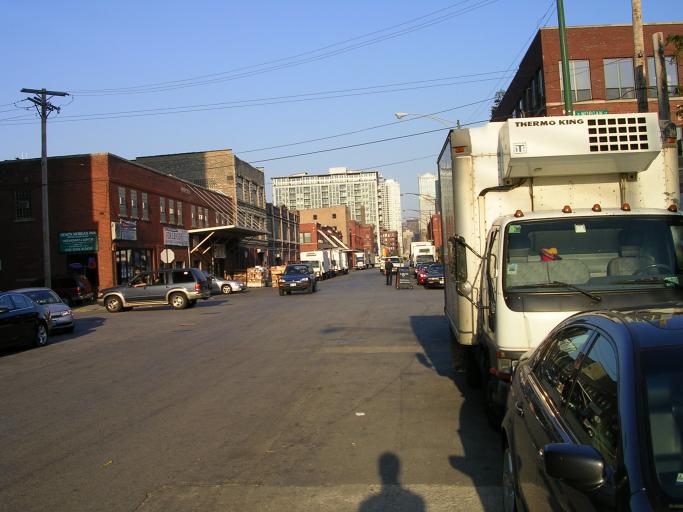
There were almost as many delivery trucks as cars. It seemed perfectly safe, just a bit odd.
moto is in a row of three or four restaurants. We originally poked our heads into otom, thinking that moto was just the sort of place that might have a sign with the name of their restaurant spelled backwards. No, we were just being stupid; moto was a couple doors down. (otom is a related restaurant, though – “the comforting counter point to the exciting gastronomic adventure of moto.”)
Here’s a look from our table at the interior of moto:
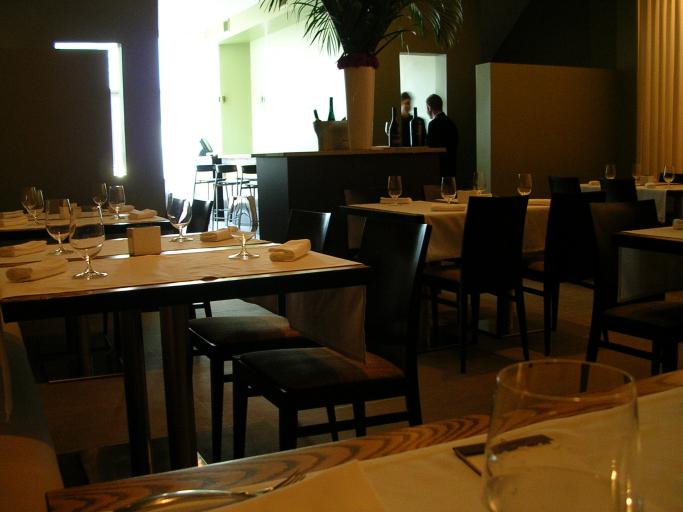
Classy but subdued decor. There was background music playing all night, a bit of an odd soundtrack ranging from bossa nova to rap. We listened and chatted while our “menus were being prepared.” I’ve had special-meal menus before, but not like this:
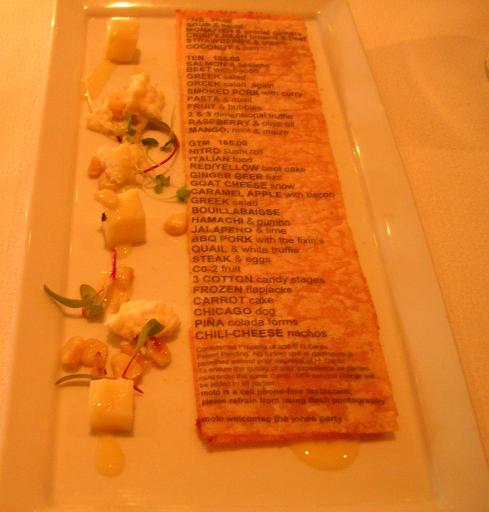
The menu was brought to each of us on a foot-long plate, with a tiny salad of potato cubes, corn, pine nuts, chèvre, and microgreens on the side. The waiter pointed out that the menus definitely had been printed especially for us:

and, of course, the menu was edible. The waiter said he’d give us some time to look over the menu, and he’d know we’d decided on our order once we started eating it. We already knew that we were going for the GTM (“grand tour moto”) – I wasn’t flying out from San Francisco to have an abridged five-course meal – but we tried nibbling the menus anyway. They certainly were edible … after a fashion. The bottom layer was like a thin cracker, and the top layer (where the menu had been printed) was very, very salty. Of course the point of an edible menu is to show that it can be done, not to reach a perfect flavor balance, so I didn’t really care that it was so salty. I ended up nibbling mine down to the GTM section:
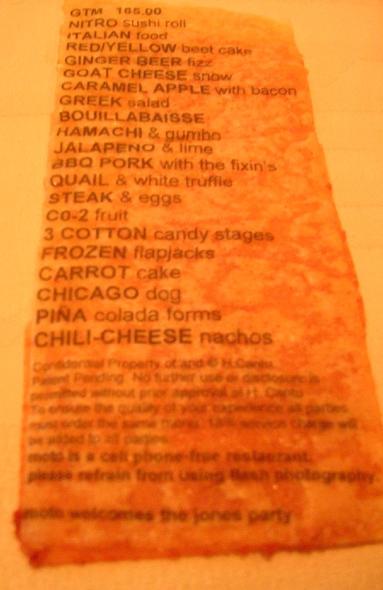
and left it like this on the side of the table, so I could see what was coming.
Course 1: “Nitro sushi roll”
Our waiter referred to this as “sushi roll, deconstructed.” It had chunks of raw salmon on the bottom, a chip like an Indian papadam, nori powder, togarashi (five-spice powder), frozen sesame powder, and a stick of pickled something (ginger?). I’m always a fan of salmon, especially in sushi, so I enjoyed this. The flavors were like a spicy salmon roll – something (maybe the togarashi?) added a lot of heat. The sesame powder, which had been frozen with liquid nitrogen, provided an unexpected balance against the heat.
Course 2: “Italian food”
A small, wide bowl with two soups: hot pizza soup and chilled Caesar salad soup. The pizza soup was thick, spicy like the dried pepper flakes at a pizza parlor, and full of cheese and Italian sausage flavor. The Caesar salad soup was thin, tasted of garlic, lettuce, and a bit of anchovies, and was topped with a couple small croutons. I’m not sure whether the white stuff drizzled on top was the source of the “dressing” flavor. Anyway, the flavors were remarkably true; this wasn’t fancy-schmancy “Italian food,” but good, hearty “Eye-talian-American” food. It was amazing how much of the pizza I could taste. The cheekiness of the dish got big laughs from the table.
Jesse and Josh got the wine pairings with this meal, and for this course they provided a little pour of a dark beer – so we could have pizza and beer!
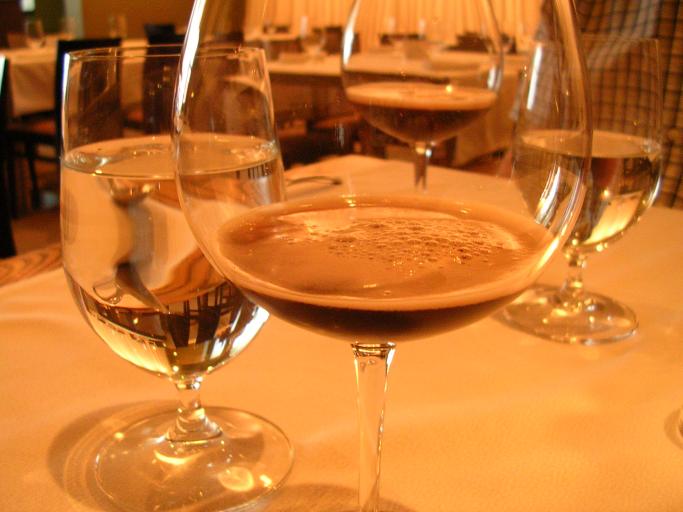
This got another round of laughter.
Course 3: “Red/yellow beet cake”
This was introduced as a course which would have us enjoying beets, even if we didn’t like them growing up. Jesse and Josh already like beets, and I think they’re okay, so that wasn’t a problem for us. The dish was many forms of red and yellow beets. On the left was the piece of beet “cake,” only a bit sweet, which felt like a dense but foamy ice cream. This was served with beet purées, pieces of raw beet, bacon, and basil. You can barely make out the yellow beet purée in my low-light picture. I enjoyed the unusual textures of beet by themselves, but the bacon and basil really made the dish – they contrasted with the beet flavor nicely.
Course 4: “Ginger beer fizz”
We were presented with wine glasses with a bit of ginger syrup at the bottom of each. The waiter then took a syringe filled with a light sarsaparilla solution and squirted the contents forcefully into each glass. This produced a nice head of foam on the drink, though when we drank it, the drink itself was confusingly not fizzy. It was light, a bit tangy, sweet but not too sweet; it also had what appeared to be little vanilla flecks swimming throughout it.
Course 5: “Goat cheese snow”
Goat cheese which had been melted and then frozen in liquid nitrogen. It was served with basil oil, so it ended up tasting like a nice pesto. The “snow” was crumbly and cold, and melted to a very thin liquid in the mouth; in texture it reminded me of the pine nut cheese that was part of the deshielo 2005 that I had at elBulli.
Course 6: “Caramel apple with bacon”
A half of a baked Gala apple, which had been partially hollowed out and filled with caramel, peanuts, bacon, and applesauce made from the apple. The streak on the “plate” is also applesauce. The silverware for eating the apple is specially designed to hold a sprig of sage; the scent of the sage can contribute to the sensory experience of the dish. It wasn’t as easy to take it all in as I would have liked – the apple skin was a bit tough to cut since we didn’t get knives, and the sage was sticking out the wrong end of the fork to really get much of the scent. I ended up sticking the sage end of the spoon undecorously under my nose while eating forkfuls of the apple, but I didn’t really mind because I thought the sage added to the dish. I really liked the flavor combinations – a gourmet caramel apple, balanced by the salt and depth of the bacon, and lifted a bit by the sage.
When the waiters brought the dish out, they mentioned something in passing about “battleship plates.” It took me a bit to understand what they were talking about, but then it was obvious:
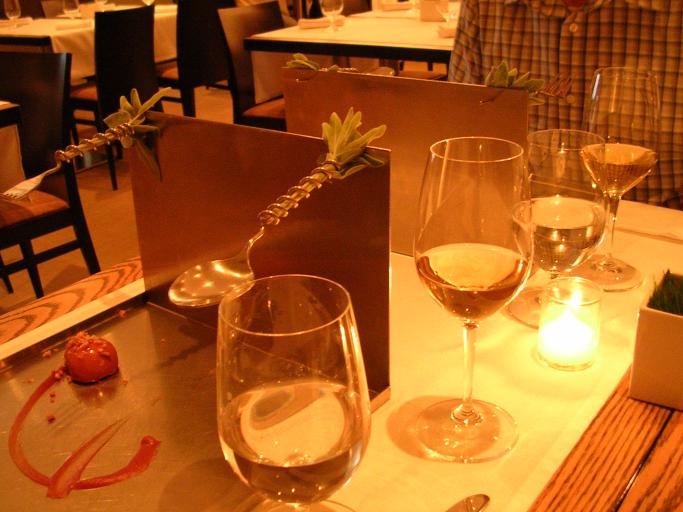
Oh, of course, Battleship plates!
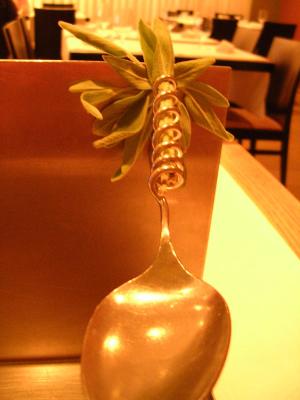
A closeup of the spoon. The “screwy” side ended in a metal peg, which plugged into a hole in the back of the “plate.”
Before the next course, a plate holding what appeared to be charcoal briquettes was brought to the table. The briquettes had been frozen in liquid nitrogen (giving them a white/black mottling), and the plate they were sitting on had a thin layer of high-proof alcohol which was flambéed by the waiter. They were left to sit for several courses, without explanation.
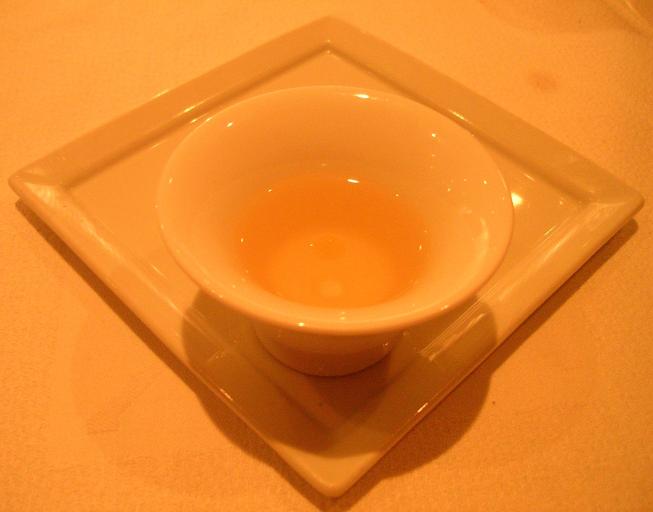
Course 7: “Greek salad”
The real seventh course was a tiny consommé of cucumber, tomato, red onion, and oregano, with a dot of extra-virgin olive oil. Greek salad is usually pretty strong, but this was mild enough to be a nice one-swallow palate cleanser. All the flavors shone through, despite the unassuming appearance of the soup.
Course 8: “Bouillabaisse”
A rich, salty saffron broth, with a long saffron “tuile,” New Zealand cockles, and Prince Edward Island mussels. The “tuile” was actually like a long, thin, fishy pork rind; it didn’t seem very strongly saffron-flavored. The wine paired with this one was quite dry, which was a welcome complement to the richness and saltiness.
Course 9: “Hamachi & gumbo”
A piece of hamachi (yellowtail fish) that had been rubbed with spices and set on a ceramic grate, served with a gumbo with abalone mushrooms. The grate had been pre-cooled in liquid nitrogen, so it left white “grill marks” on the fish when you picked the fish up! Moreover, the parts of the fish that had touched the “grill” made the fish feel more flaky and cooked-textured, contrasting with the nearly sushi-like smoothness elsewhere. (The fish wasn’t actually raw, but had been cooked in warm olive oil.) The gumbo was rich, fishy, sweet, quite spicy, and had a strong paprika flavor.
I was really impressed by this course: the technical cleverness which showed off an unexpected effect, the beautiful tenderness of the fish, and and the well-balanced pairing of the fish with the soup.
Course 10: “Jalapeno & lime”
A scoop of jalapeño ice cream, cubes of avocado, toasted quinoa, and a tequila-lime margarita sauce. I thought it was okay; Josh said it was his least favorite dish of the evening. I don’t think any of us would have thought of “margarita” if it hadn’t been mentioned.
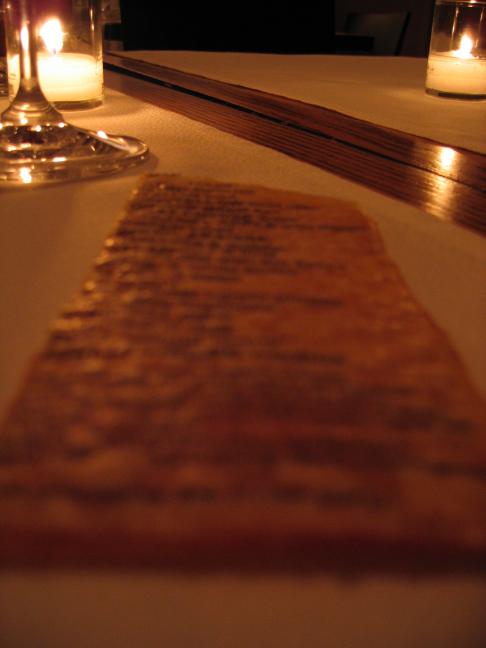
The restaurant, which was empty when we arrived for our 6:00 PM reservation, was mostly full by this point. Luckily, we weren’t full at all yet, because we were only half done with the meal.
Course 11: “BBQ pork with the fixin’s”
The identity of the “charcoal briquettes” was revealed. They were rough-cut pieces of high-gluten Pullman bread, dipped in squid ink, toasted in olive oil, then frozen in liquid nitrogen. The waiter took two “briquettes” and added them to each person’s plate, which had a piece of very tender pork, Kansas City-style barbecue sauce, and Pullman bread purée. This was another marvel. The pork was fall-off-the-bone tender, but didn’t seem to actually have been barbecued. (Maybe cooked sous vide?) The briquettes, which had a nice toasty texture, seemed to add grill flavor even though I knew it was squid ink. My mouth and my eyes disagreed about what was going on, but my mouth won.
Course 12: “Quail & white truffle”
Despite the name, this was actually a take on macaroni and cheese. The small, warm glass had a piece of quail meat at the bottom, some cooked and dehydrated macaroni, smoked cheddar purée, powdered truffle oil, and chives. The macaroni were unexpectedly crispy (but not rock-hard like uncooked macaroni). They played against the smooth, rich quail, the richness of the cheese, some mysterious spicy heat, and the fumes of the truffle oil brought out by the warmth of the glass. It was some of the biggest-flavored “comfort food” I’ve ever had. Damn fine.
Course 13: “Steak & eggs”
Deconstructed steak and eggs. The cube on the left was steamed egg white. The egg yolk had been softly cooked, mixed with puréed spinach, piped back into a hole in the middle, and topped with micro-arugula. The slices in the middle were tender prime rib with a “smear” of shallot and mustard purée. On the right was a “moto hash brown” in a puddle of heirloom tomato purée.
I’m not much of a steak person myself, much less steak-and-eggs, so this didn’t do a whole lot for me. The tomato purée tasted nothing like ketchup, but was an intriguing alternative.

Josh contemplates his steak and eggs.
Course 14: “CO2 fruit”
A bunch of different things going on here. Starting from the left, there’s a white rice “chip” with blackcurrant and butternut squash flavoring powder, a cinnamon-infused apple slice and a vanilla-infused asian pear slice underneath, chopped bits of black walnut, a cube of carbonated watermelon, and a mixture of triple-creme cheese and white chocolate. I was really skeptical of the cheese and chocolate mixture, but there was a surprisingly good balance between the two flavors, and it served as a nice dip for the apple and the pear. The apple and pear tasted surprisingly natural – again, a nice flavor balance. And I don’t know how CO2 was used in most of the preparations, but it was obvious with the watermelon cube: it had a wonderful, really potent fizz. Apparently they just cut up cubes of watermelon and pumped carbon dioxide into them, like how a water carbonation machine works. Jesse mentioned that he was installing a home carbonation machine, and said he’d definitely have to try carbonating some watermelon. This was one of his favorite dishes.
Our waiter had told us earlier in the meal that he was actually a cook too. Many of the waitstaff at moto are first and foremost cooks, who are assigned to do regular rotations working the front of the house. As a result, he was able to tell us a lot about the dishes, and he pointed out that the flavored rice chip in this course was one of his inventions. He was also more excited about presenting the dishes than most waiters I’ve seen; I think his approach would be out of place in some restaurants, but it seems like a very natural thing when you put cooks out front. It reminds me of what happens in my line of work (software development) when you send an engineer, rather than a salesman, to talk with a customer. It can be great for both people, but you have to be ready for it.
I did ask him why he thought Chicago was a hot spot for molecular gastronomy, and he agreed that Charlie Trotter probably had a lot to do with it. So that’s one hunch confirmed.
Course 15: “3 cotton candy stages”
Three unexpected forms of cotton candy. The “paper” was completely edible, made using super-secret technology of course, and tasted vaguely but unmistakably like cotton candy. The ball was made of white chocolate and nonpareils, and had a cold thin liquid center that tasted of cotton candy. It was interesting, but the flavor of the liquid only lasted a second or so, and was quickly replaced by the flavor of white chocolate. (The nonpareils added an unexpected texture contrast.) The “tangle” was described as “fried cotton candy and cotton candy powder.” I sure can’t imagine frying any cotton candy I’ve ever seen, but whatever they did, it was a hit. It was an instant State Fair flashback – pure cotton candy flavor and a side of deep-fried deep fry.
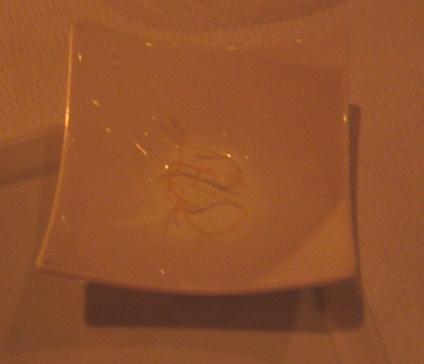
Course 16: “Flapjacks prepared tableside”
We had been seeing a cold box get wheeled around all evening, and now it was our turn to see it close up. It was cooled from the inside by liquid nitrogen (of course), and acted as a “griddle” on the top surface. Our waiter poured three nickel-sized puddles of crème anglaise onto the top of the box, waited a few seconds until they solidified, flipped the “flapjacks,” waited a few more seconds for the second side to “cook” …
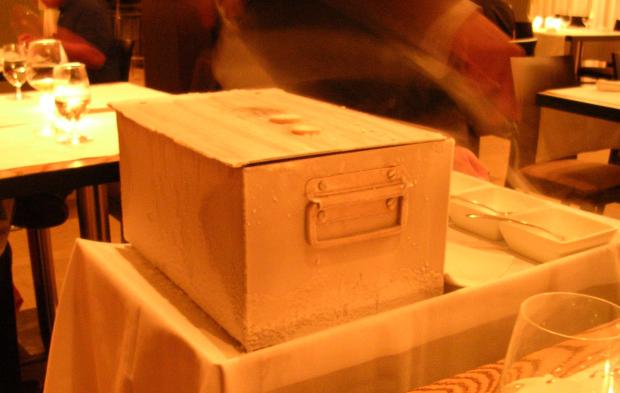
then picked each one up with a spatula and placed it quickly into a waiting spoon. The spoons had been prepared with a small puddle of rich maple syrup in each one. Another interesting illustration of what liquid nitrogen can do – the crème anglaise definitely had the texture of a (really cold) cooked pancake! This seemed like a direct copy of the Morphings that I had at elBulli, but adapted to play up the breakfast food aspect of the experience. Lots of fun.
Course 17: “Carrot cake”
Freshly made carrot cake, served in several different forms: soup (!), a tuile, croutons, and cream. All four forms were not just carroty, but carrot-cakey. Since the croutons were made from carrot cake, they were very dense and chewy.
Course 18: “Chicago dog”
By about this point in the meal, there was no question that we were getting full. Jesse had been looking at the “Chicago dog” lurking at the end of the menu with a bit of indigestion; yes, things are different at moto, and maybe it makes sense to have a big hunk of hot dog and fixin’s at the end of a meal, but it sure sounds like a gut bomb. Of course, we had nothing to fear. The hot dog that we were served was about as long as my thumb, and was strictly dessert: a muffiny brown-butter bun, a “hot dog” of strawberry sorbet, a “tomato slice” of raspberry gelee, cubes of “relish” made from green tomato gelee, asian pear “horseradish,” and lemon curd “mustard.” The strawberry sorbet had a strikingly realistic “hot dog end” pattern on each side, adding to the realism. The fruity flavors and the chill of the sorbet were nicely refreshing, while the experience of looking at what seemed to be a bit of aggressive street food and tasting refined fruitiness kept us off guard.
Course 19: “Pina colada forms”
Rum ice cream, coconut foam, toasted coconut, and pineapple powder. Pleasant, but the ice cream wasn’t as rummy as I might have liked.
Course 20: “Chili-cheese nachos”
We’d been looking at this one with as much trepidation as the “Chicago dog,” and again, we had nothing to worry about. The “nacho” was a bit of sweetened corn tortilla; it was topped with chocolate “ground beef,” “Pace picante sauce” of strawberries, and mango “cheese.” Another good round of laughs for this one. The chocolate was strong and tasty, which normally I don’t mind at all, but here it took away a bit from the rest of the dish, which was cool and light and refreshing.
As “mignardises,” we got some packing peanuts:
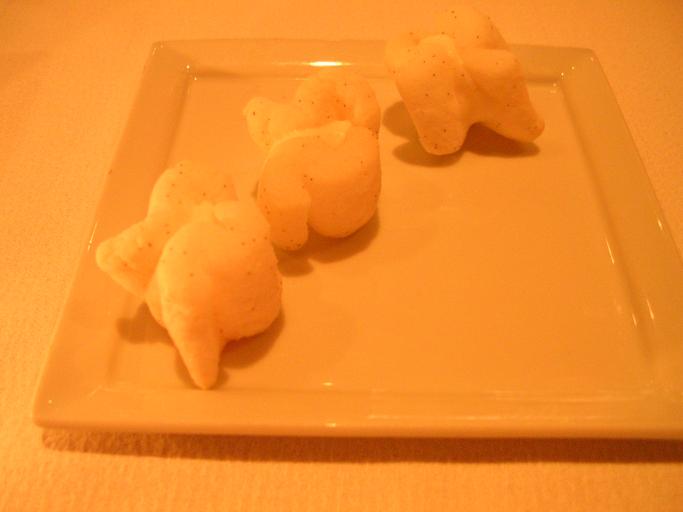
These were a lot like the biodegradable packing peanuts, but made with vanilla crème anglaise and vanilla sugar. I’ve never eaten one of the real peanuts, but I suspect this one was better than most.
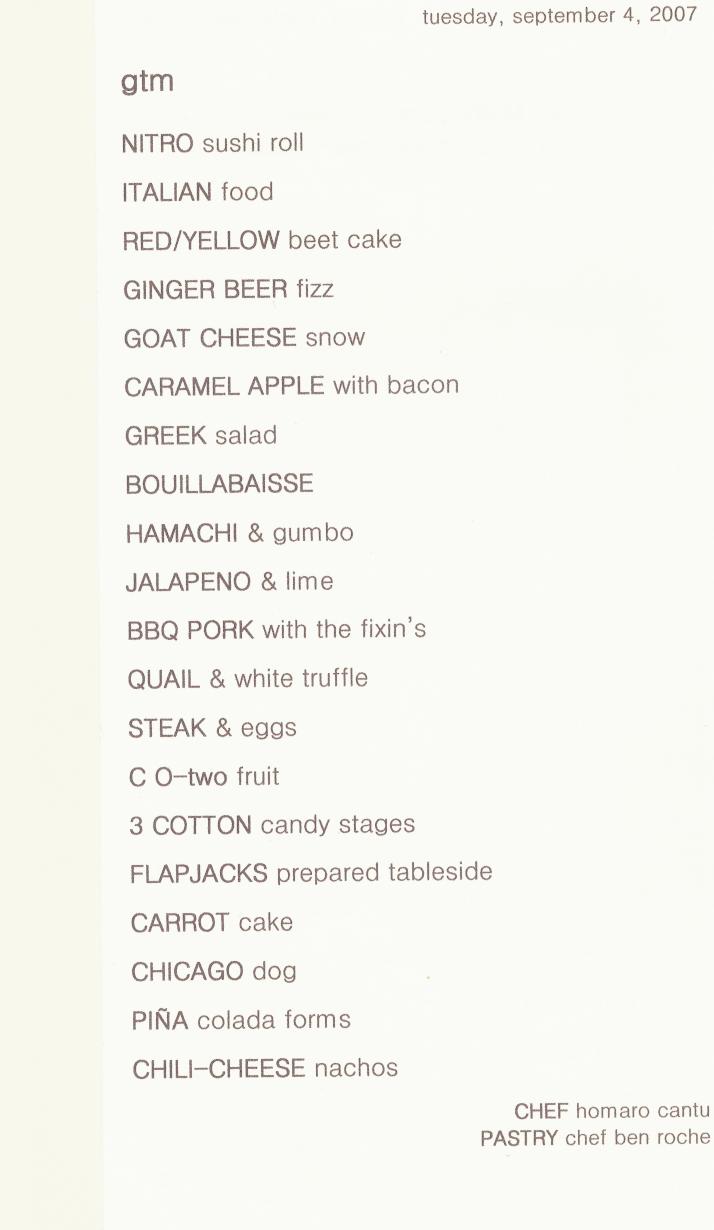
Quite a meal. We went back to the hotel full and beaming. We played tourist for a couple days, seeing the city by foot and by El, and sweating off the remains of our big meal in the hot and humid Chicago summer. By Thursday evening we had walked enough, and were ready and excited for our trip to Alinea.




